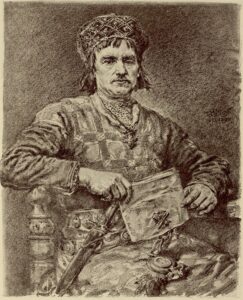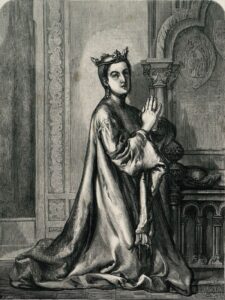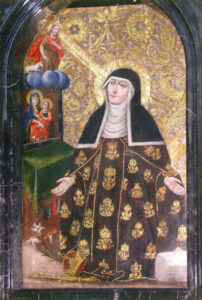Saint Kinga, as the wife of the Cracovian Duke Bolesław the Chaste, was an exceptionally pious person. Unlike many medieval women, she did not want to consummate her marriage and provide her partner with offspring. Instead, she preferred to live in celibacy, which caused a serious dispute between the spouses. How did this conflict end? What did the duchess’s life look like? Here is the biography of Kinga, one of the most religious women of Polish medieval times.
Marriage to the Chaste Duke
Saint Kinga came into the world in 1234 as the daughter of King Béla IV of Hungary and Maria Laskarina, daughter of the Nicaean Emperor Theodore. Already at the age of five, she came to Poland, where she was betrothed to the heir to the Cracovian throne, Duke Bolesław V the Chaste, son of Duke Leszek the White of Cracow, who had died in tragic circumstances.
Bolesław’s chosen one grew up to become a beautiful and eloquent woman, able to speak several languages, including Polish. According to the lives of St. Kinga, Bolesław’s sister Salomea helped bring the Polish and Hungarian courts together by persuading Béla’s daughter to travel to Poland. In reality – as scholars argue – this marriage was mainly desired by the Cracovian lords, who could derive numerous benefits from an alliance with the Árpád state.
When Kinga reached marriageable age (12 years old), she married Bolesław the Chaste. The wedding ceremonies took place in Cracow, where crowds of guests flocked, celebrating almost continuously for twelve days. At least that’s how our great chronicler Jan Długosz saw it from a 15th-century perspective, though he sometimes fantasized in his written „Annals”.

Bolesław the Chaste, by marrying the Árpád princess, received an enormous dowry which – according to sources – amounted to 40,000 marks. But this was probably not the most important thing for Leszek the White’s son, because thanks to his marriage to Kinga, his position on the international stage increased immeasurably. His father-in-law was one of the most significant players in this part of Europe.
Kinga and Her White Marriage
Duchess Kinga, unlike most wives of Polish rulers, decided from the beginning of her marriage to live without sex. She was able to convince her husband of this intention over time, which shows that she had significant influence over at least part of his actions.
From available source accounts, we learn that the duchess first persuaded Bolesław the Chaste to persevere in abstinence for a year. When this period passed, the Árpád princess managed to negotiate an extension of this period by another twelve months.
However, this was not enough for Kinga and – as we read in the hagiographic works describing her life – she proposed to her husband that they remain in a white marriage until the end of their days. Bolesław the Chaste, however, did not want to agree to this, because he sought to father offspring who would take over supreme rule in Poland after his death. The arguments used by the man did not appeal to Kinga at all, who stubbornly defended her position.

Given the above, it is not surprising that Cracow became a kind of arena of struggle between the spouses for a certain time. At one point, Bolesław announced to Kinga that if she did not change her behavior, he would take a mistress who would give him the desired heir. But even this threat could not persuade the woman to make concessions, which only shows that she had an extremely strong character.
Finally, Leszek the White’s son gave up, though it took quite some time before this happened. Together with his wife, he made solemn vows of chastity in the presence of Bishop Jan Prandota of Cracow. From then on, the couple – according to sources – lived like brother and sister. This marriage was therefore never consummated.
Kinga as Lady of Sącz
Kinga proved to be not only a deeply spiritual person, but also one who kept her feet firmly on the ground. She had her own seal, which she used many times when issuing documents. Most often she issued them together with her husband or mother-in-law, Duchess Grzymisława, but she also appeared independently on some of them.
At the beginning of 1257, Kinga received the Sącz region from her husband as hereditary property. The duchess managed this land energetically, contributing to its economic development. She founded more than a dozen new villages, to which she brought settlers from outside.
As Lady of Sącz, Kinga was virtually adored by the inhabitants of the entire region, whom she constantly granted new privileges and immunities. The people of Sącz were repeatedly exempted from customs duties, which enabled the development of local trade.

Alongside Her Husband
Kinga had to flee Poland twice with her husband. This happened in 1241 and 1259, when Polish lands were attacked by the Mongols, who had no respect for anyone or anything. During the second invasion, the couple took refuge in Hungary, from where they returned to the country after the threat had passed. The destruction left behind by the invaders had to be rebuilt over many long years. Sources indicate that Kinga played an important role in this process.
In 1270, Kinga was visited in Cracow by her brother, the then King Stephen V of Hungary. The spouses worthily received the family member, participating in tournaments and feasts organized in his honor. During all these celebrations, the woman constantly accompanied her husband, with whom she apparently very much enjoyed spending time.
See also: The Tragic Death of Leszek the White, Husband of Grzymisława
The Hungarian experienced difficult moments on December 7, 1279, when her husband died. After the solemn burial of Bolesław’s body in the Franciscan church in Cracow, the widowed duchess donned a religious habit and entered the Poor Clare convent in Stary Sącz, of which she was the founder.
Kinga’s Death and Religious Activity
During the last months of her life, Kinga struggled with a serious illness, which led her to the grave on July 24, 1292. She was buried in Stary Sącz in the local monastic chapel.
Even during her lifetime, Kinga was considered a saint. It is therefore not surprising that shortly after her death, efforts began to raise her to the altars. The canonization finally took place in 1999 after Pope John Paul II’s visit to Stary Sacz.
Kinga, like most Polish duchesses during the period of feudal fragmentation, conducted large-scale charitable activities. She cared for people on the margins of society.
See also: Wierzchosława – The Love of Bolesław the Curly’s Life
New shelters and monasteries were established on the duchess’s initiative. She looked after religious orders, primarily female ones, and spared no expense for them. At the same time, she popularized Christological and Marian worship in Polish lands by promoting appropriate devotions.
Bibliography
- Barański M., Dominium sądeckie, Od książęcego okręgu grodowego do majątku klarysek sądeckich, Warszawa 1992.
- Kowalska M., Święta Kinga – rzeczywistość i legenda, Studium źródłoznawcze, Kraków 2008.
- Maciaszek K., Bolesław V Wstydliwy, Książę krakowski i sandomierski 1226-1279, Długie panowanie w trudnych czasach, Kraków 2021.
- Michalski M., Kobiety i świętość w żywotach trzynastowiecznych księżnych polskich, Poznań 2004.
- Rosik S., Wiszewski P., Wielki poczet polskich królów i książąt, Wrocław 2006.
Author: Mariusz Samp